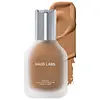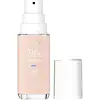Haus Labs By Lady Gaga Triclone Skin Tech Medium Coverage Foundation with Fermented Arnica Versus L'Oreal True Match Super-Blendable Foundation
What's inside
What's inside
 Key Ingredients
Key Ingredients

 Benefits
Benefits

 Concerns
Concerns

 Ingredients Side-by-side
Ingredients Side-by-side

Water
Skin ConditioningDiphenylsiloxy Phenyl Trimethicone
Skin ConditioningPhenyl Trimethicone
Skin ConditioningCaprylyl Methicone
Skin ConditioningTrimethylsiloxysilicate
EmollientPropylene Glycol Dibenzoate
Skin ConditioningIsododecane
EmollientGlycerin
HumectantButylene Glycol
HumectantMethyl Trimethicone
Skin ConditioningLauryl Polyglyceryl-3 Polydimethylsiloxyethyl Dimethicone
Skin ConditioningC13-15 Alkane
SolventPolyglyceryl-3 Polydimethylsiloxyethyl Dimethicone
Skin ConditioningAlcohol Denat.
AntimicrobialAcrylates/Polytrimethylsiloxymethacrylate Copolymer
Skin ConditioningPolymethylsilsesquioxane
Sorbitan Sesquioleate
EmulsifyingDisteardimonium Hectorite
Stabilising1,2-Hexanediol
Skin ConditioningPalmitoyl Tetrapeptide-10
Skin ConditioningArnica Montana Flower Extract
MaskingHydrolyzed Hyaluronic Acid
HumectantSqualane
EmollientPseudozyma Epicola/Camellia Sinensis Seed Oil Ferment Extract Filtrate
HumectantPrunus Armeniaca Kernel Oil
MaskingSolanum Lycopersicum Fruit Extract
AntioxidantDunaliella Salina Extract
Skin ConditioningHedychium Coronarium Root Extract
MaskingTocopherol
AntioxidantAlthaea Rosea Flower Extract
Skin ConditioningTaraxacum Officinale Extract
Skin ConditioningPerilla Ocymoides Leaf Extract
TonicPanax Notoginseng Extract
Skin ConditioningGlycyrrhiza Glabra Root Extract
BleachingChamomilla Recutita Extract
Skin ConditioningCentella Asiatica Extract
CleansingPseudozyma Epicola/Sunflower Seed Oil Ferment Extract Filtrate
Emulsion StabilisingCaprylyl Glycol
EmollientEthylhexylglycerin
Skin ConditioningMagnesium Sulfate
Polypropylsilsesquioxane
Acrylates/Dimethicone Copolymer
Skin ConditioningTriethoxycaprylylsilane
Dimethicone/Vinyl Dimethicone Crosspolymer
Skin ConditioningAluminum Hydroxide
EmollientCI 77891
Cosmetic ColorantCI 77491
Cosmetic ColorantWater, Diphenylsiloxy Phenyl Trimethicone, Phenyl Trimethicone, Caprylyl Methicone, Trimethylsiloxysilicate, Propylene Glycol Dibenzoate, Isododecane, Glycerin, Butylene Glycol, Methyl Trimethicone, Lauryl Polyglyceryl-3 Polydimethylsiloxyethyl Dimethicone, C13-15 Alkane, Polyglyceryl-3 Polydimethylsiloxyethyl Dimethicone, Alcohol Denat., Acrylates/Polytrimethylsiloxymethacrylate Copolymer, Polymethylsilsesquioxane, Sorbitan Sesquioleate, Disteardimonium Hectorite, 1,2-Hexanediol, Palmitoyl Tetrapeptide-10, Arnica Montana Flower Extract, Hydrolyzed Hyaluronic Acid, Squalane, Pseudozyma Epicola/Camellia Sinensis Seed Oil Ferment Extract Filtrate, Prunus Armeniaca Kernel Oil, Solanum Lycopersicum Fruit Extract, Dunaliella Salina Extract, Hedychium Coronarium Root Extract, Tocopherol, Althaea Rosea Flower Extract, Taraxacum Officinale Extract, Perilla Ocymoides Leaf Extract, Panax Notoginseng Extract, Glycyrrhiza Glabra Root Extract, Chamomilla Recutita Extract, Centella Asiatica Extract, Pseudozyma Epicola/Sunflower Seed Oil Ferment Extract Filtrate, Caprylyl Glycol, Ethylhexylglycerin, Magnesium Sulfate, Polypropylsilsesquioxane, Acrylates/Dimethicone Copolymer, Triethoxycaprylylsilane, Dimethicone/Vinyl Dimethicone Crosspolymer, Aluminum Hydroxide, CI 77891, CI 77491
Water
Skin ConditioningDimethicone
EmollientIsododecane
EmollientCyclohexasiloxane
EmollientGlycerin
HumectantPEG-10 Dimethicone
Skin ConditioningMethyl Methacrylate Crosspolymer
Butylene Glycol
HumectantPentylene Glycol
Skin ConditioningSynthetic Fluorphlogopite
Disteardimonium Hectorite
StabilisingHydroxyethylpiperazine Ethane Sulfonic Acid
BufferingCetyl PEG/PPG-10/1 Dimethicone
EmulsifyingSodium Chloride
MaskingPolyglyceryl-4 Isostearate
EmulsifyingHexyl Laurate
EmollientCaprylyl Glycol
EmollientPhenoxyethanol
PreservativeDisodium Stearoyl Glutamate
CleansingTocopherol
AntioxidantSilica
AbrasivePanthenol
Skin ConditioningAluminum Hydroxide
EmollientHydroxyethyl Urea
HumectantAloe Barbadensis Leaf Juice Powder
Skin ConditioningSodium Hyaluronate
HumectantPentaerythrityl Tetra-Di-T-Butyl Hydroxyhydrocinnamate
AntioxidantTitanium Dioxide
Cosmetic ColorantCI 77491
Cosmetic ColorantCI 77492
Cosmetic ColorantCI 77499
Cosmetic ColorantCI 77007
Cosmetic ColorantCI 77288
Cosmetic ColorantWater, Dimethicone, Isododecane, Cyclohexasiloxane, Glycerin, PEG-10 Dimethicone, Methyl Methacrylate Crosspolymer, Butylene Glycol, Pentylene Glycol, Synthetic Fluorphlogopite, Disteardimonium Hectorite, Hydroxyethylpiperazine Ethane Sulfonic Acid, Cetyl PEG/PPG-10/1 Dimethicone, Sodium Chloride, Polyglyceryl-4 Isostearate, Hexyl Laurate, Caprylyl Glycol, Phenoxyethanol, Disodium Stearoyl Glutamate, Tocopherol, Silica, Panthenol, Aluminum Hydroxide, Hydroxyethyl Urea, Aloe Barbadensis Leaf Juice Powder, Sodium Hyaluronate, Pentaerythrityl Tetra-Di-T-Butyl Hydroxyhydrocinnamate, Titanium Dioxide, CI 77491, CI 77492, CI 77499, CI 77007, CI 77288
 Reviews
Reviews

Ingredients Explained
These ingredients are found in both products.
Ingredients higher up in an ingredient list are typically present in a larger amount.
Aluminum Hydroxide is a form of aluminum. It can be naturally found in nature as the mineral gibbsite. In cosmetics, Aluminum Hydroxide is used as a colorant, pH adjuster, and absorbent.
As a colorant, Aluminum Hydroxide may add opacity, or reduce the transparency. Aluminum hydroxide is contains both basic and acidic properties.
According to manufacturers, this ingredient is an emollient and humectant. This means it helps hydrate the skin.
In medicine, this ingredient is used to help relieve heartburn and help heal ulcers.
There is currently no credible scientific evidence linking aluminum hydroxide in cosmetics to increased cancer risk.
Major health organizations allow the use of aluminum hydroxide in personal care products and have not flagged it as a carcinogenic risk at typical usage levels.
Learn more about Aluminum HydroxideButylene Glycol (or BG) is used within cosmetic products for a few different reasons:
Overall, Butylene Glycol is a safe and well-rounded ingredient that works well with other ingredients.
Though this ingredient works well with most skin types, some people with sensitive skin may experience a reaction such as allergic rashes, closed comedones, or itchiness.
Learn more about Butylene GlycolCaprylyl Glycol is a humectant and emollient, meaning it attracts and preserves moisture.
It is a common ingredient in many products, especially those designed to hydrate skin. The primary benefits are retaining moisture, skin softening, and promoting a healthy skin barrier.
Though Caprylyl Glycol is an alcohol derived from fatty acids, it is not the kind that can dry out skin.
This ingredient is also used as a preservative to extend the life of products. It has slight antimicrobial properties.
Learn more about Caprylyl GlycolCi 77491 is also hydrated iron III oxide. It's sole purpose is to give a red/pink hue to products.
Iron III oxides are classified as inorganic chemicals for coloring.
Synthetically created Ci 77491 is considered safer than those naturally found. This is because the synthetically created version may contain less impurities. Iron oxides are generally non-toxic and non-allergenic.
Learn more about CI 77491Disteardimonium Hectorite comes from the clay mineral named hectorite. It is used to add thickness to a product.
It can also help stabilize a product by helping to disperse other ingredients.
Hectorite is a rare, white clay mineral.
Learn more about Disteardimonium HectoriteGlycerin is already naturally found in your skin. It helps moisturize and protect your skin.
A study from 2016 found glycerin to be more effective as a humectant than AHAs and hyaluronic acid.
As a humectant, it helps the skin stay hydrated by pulling moisture to your skin. The low molecular weight of glycerin allows it to pull moisture into the deeper layers of your skin.
Hydrated skin improves your skin barrier; Your skin barrier helps protect against irritants and bacteria.
Glycerin has also been found to have antimicrobial and antiviral properties. Due to these properties, glycerin is often used in wound and burn treatments.
In cosmetics, glycerin is usually derived from plants such as soybean or palm. However, it can also be sourced from animals, such as tallow or animal fat.
This ingredient is organic, colorless, odorless, and non-toxic.
Glycerin is the name for this ingredient in American English. British English uses Glycerol/Glycerine.
Learn more about GlycerinIsododecane is a fragrance, emollient, and solvent.
As an emollient, it helps your skin stay soft and hydrated. Emollients help trap moisture into your skin.
Isododecane's role as a solvent makes it a great texture enhancer. It spreads smoothly on skin and does not leave a sticky feeling behind. Isododecane also helps prevent color transfer in makeup products.
Isododecane is not absorbed into skin.
Learn more about IsododecaneTocopherol (also known as Vitamin E) is a common antioxidant used to help protect the skin from free-radicals and strengthen the skin barrier. It's also fat soluble - this means our skin is great at absorbing it.
Vitamin E also helps keep your natural skin lipids healthy. Your lipid skin barrier naturally consists of lipids, ceramides, and fatty acids. Vitamin E offers extra protection for your skin’s lipid barrier, keeping your skin healthy and nourished.
Another benefit is a bit of UV protection. Vitamin E helps reduce the damage caused by UVB rays. (It should not replace your sunscreen). Combining it with Vitamin C can decrease sunburned cells and hyperpigmentation after UV exposure.
You might have noticed Vitamin E + C often paired together. This is because it is great at stabilizing Vitamin C. Using the two together helps increase the effectiveness of both ingredients.
There are often claims that Vitamin E can reduce/prevent scarring, but these claims haven't been confirmed by scientific research.
Learn more about TocopherolWater. It's the most common cosmetic ingredient of all. You'll usually see it at the top of ingredient lists, meaning that it makes up the largest part of the product.
So why is it so popular? Water most often acts as a solvent - this means that it helps dissolve other ingredients into the formulation.
You'll also recognize water as that liquid we all need to stay alive. If you see this, drink a glass of water. Stay hydrated!
Learn more about Water